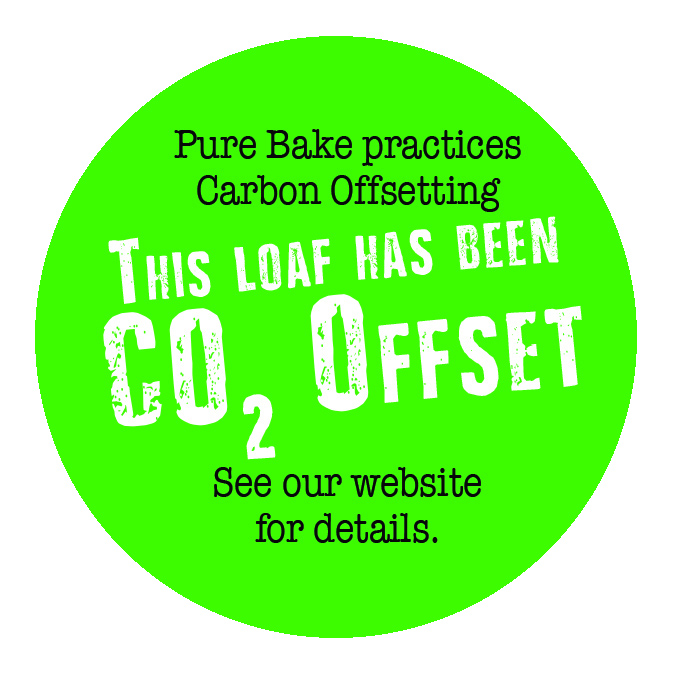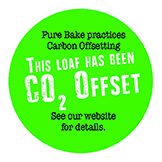Carbon Offsetting One Loaf at a Time

Pure Bake is carbon offsetting now. To do this, we use a social enterprise company that provides carbon offsetting products to individuals and businesses. Social enterprises are organizations that apply commercial strategies “to maximize improvements in financial, social, and environmental well-being…“-Wikipedia.
We calculate all of the carbon we release in the process of preparing, baking, and delivering our bread. This is what we offset through the purchase of carbon offsets. Calculating the carbon cost of the products we use, flour, salt, water, and packaging materials, is a bit more complicated to figure. Nevertheless, we intend to eventually include these in our offsets.
Baking bread is such a benign thing to do. Baking artisan bread is even more benign. But there has always been something that really bothered me about it: gas, natural, and otherwise. The ovens are on almost every day for a few hours. Every delivery day involves about 40 miles of travel. For a person who has been a vegan for some time now and a vegetarian for decades, this doesn’t sit well. I became a vegetarian because of the environment first, animals second. Either way, being a vegan is an environmentalist doing one thing he can actually do about climate change.
But the gas. Oh, the gas. Natural gas and gasoline. Not so benign.
Carbon offsetting is available to all businesses now. “A carbon offset is a reduction in emissions of carbon dioxide or other greenhouse gases made in order to compensate for emissions made elsewhere.”-Wikipedia. It’s not just for developing countries and multi-national corporations. Pure Bake does it too. There are companies that sell you the offsets. With the money, paid monthly, they invest in environmental projects around the world.
Carbon offsetting lets a business take responsibility for its own carbon emissions by reducing emissions somewhere else.
Calculate your business’ carbon footprint. Purchase enough offsets to offset your footprint.
Here is an in-depth explanation of what the carbon offsets achieve.
Example Projects
Our offset provider funds projects that destroy greenhouse gases and produce renewable energy. they do this by partnering with project owners in communities across North America and the world. They are able to support these projects through the sale of carbon offsets.
Types of Supported Projects
Farm power: Works with farms to make the best possible use of animal waste. Through the use of anaerobic digesters, methane is captured as the manure breaks down and is then destroyed when it is burned as a fuel to produce electricity. Additionally, these digesters can produce a variety of other products that help the farm and reduce environmental impact. The fibrous material can be separated, dried, and used as bedding, while the liquid effluent can be used as fertilizer. Anaerobic digestion also aids local communities by helping to reduce water pollution and odor associated with animal husbandry.
Landfill gas capture: Landfill gas capture projects turn garbage into power. As organic waste breaks down, it releases methane, a greenhouse gas 84 times more powerful than CO2. According to the EPA, landfills are the third-largest source of methane emissions in the United States. Through the installation of gas collection and control systems, these projects result in the destruction of powerful greenhouse gases, and the gas can be burned in a generator to create renewable electricity.
Clean energy from wind power: Wind energy displaces electricity that is generated by dirty fossil fuels like gas and coal (the way that most power is currently generated in the United States). In this sense, the amount of carbon dioxide emissions that are avoided depends upon the “carbon profile” of the electricity grid where the energy is produced. The carbon profile of each regional grid is calculated periodically by the US Environmental Protection Agency by adding up the weighted average carbon dioxide emissions of all commercial energy sources on that regional grid.
Abandoned coal mine methane capture: Coal mines are a major source of methane emissions in the US, as methane gas naturally exists in coal beds and is released into the atmosphere through mine shafts. Methane escapes both from active mines and from abandoned mines that have reached the end of their useful life. Our provider only supports methane capture projects at abandoned coal mines, as they seek to avoid providing any benefit or incentive to companies involved in mining operations. Like other methane capture projects, powerful greenhouse gases are destroyed and can also be used to generate electricity, thus providing a “double” benefit.
How do we know these are high-quality projects?
Our carbon offset provider supports specific carbon offset standards, which assure transparency and quality in the creation, quantification, and verification of offset projects. These standards require that offsets be real, additional (i.e., they wouldn’t have happened under a “business as usual” scenario), permanent, quantifiable, never double-counted or double-sold and independently verified.
Currently, our provider uses the Verified Carbon Standard, Gold Standard, American Carbon Registry and the Climate Action Reserve as our only carbon offset standards.
How do we know that the projects are actually making a difference?
Our provider ensures our offsets are making a difference in several ways. Prior to adding a project to our portfolio, they perform due diligence to fully understand the impact of each project. Once the project is in our portfolio, they monitor and verify all of the emissions reductions that are taking place. Finally, all projects in our portfolio must pass the “additionality” test. Additionality refers to the concept of whether your carbon offset purchase really brings about carbon reductions, or whether the reductions would have happened anyway. If the purchase of carbon offsets is a critical factor in making the reductions happen, the reductions are said to be “additional” to the business-as-usual case. By verifying and checking at each step in the process, they are committed to making sure the projects are restoring the balance.

Carbon offsets are crucial to the transition to cleaner energy. We can use this same process to purchase more offsets than we actually need, thereby funding more environmental projects through the same organization.
Please share. And encourage your local artisan bread baker to practice carbon offsetting.
Thanks. Robert Lewis
